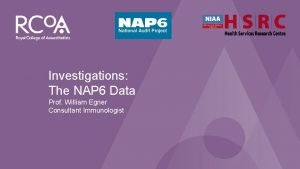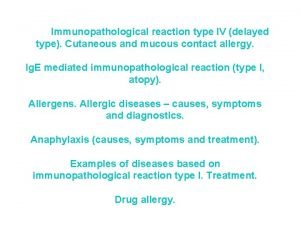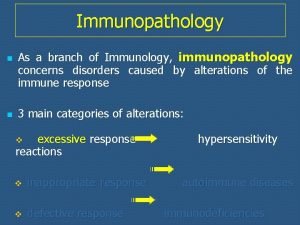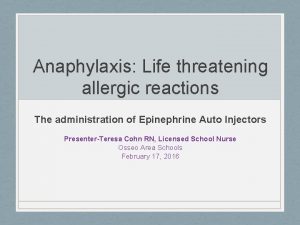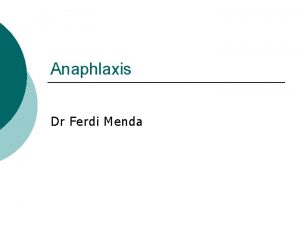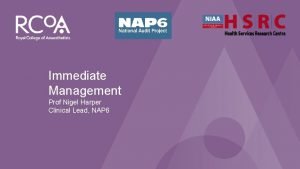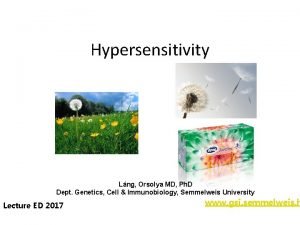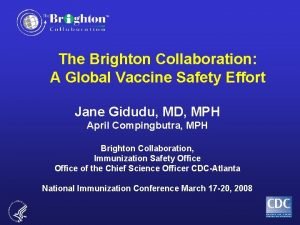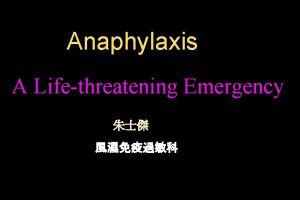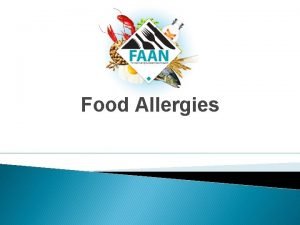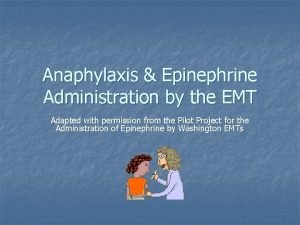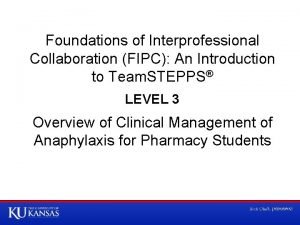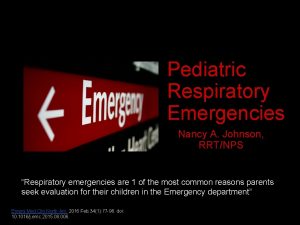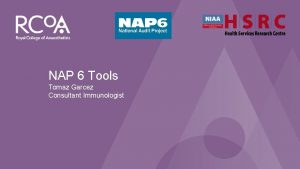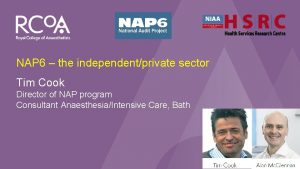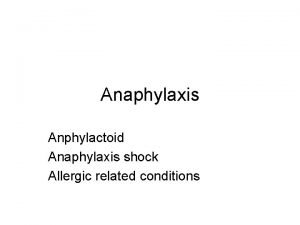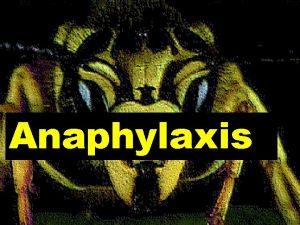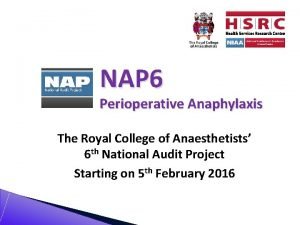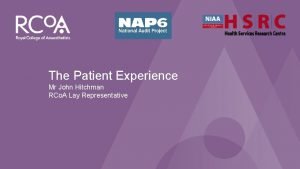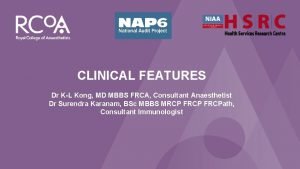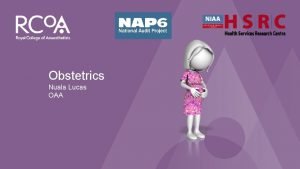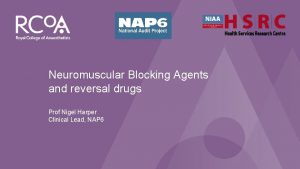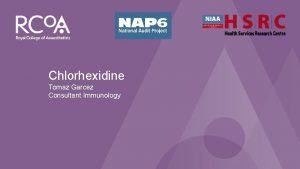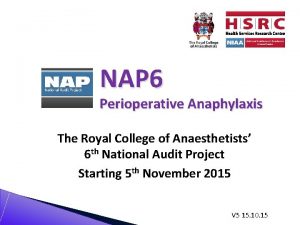NAP 6 Perioperative Anaphylaxis Investigations The NAP 6
















- Slides: 16

NAP 6: Perioperative Anaphylaxis Investigations: The NAP 6 Data Prof. William Egner Consultant Immunologist

NAP 6: Perioperative Anaphylaxis Guidelines used NICE CG 183 • N 1 written information • • • N 1. 1 Allergic or non-allergic reaction N 1. 2 Drug name and a description of their reaction N 1. 3 Investigations used N 1. 4 Drugs or drug classes to avoid in future N 1. 5 Safe alternative drugs to use N 2. 1 structured written info. to patient AAGBI • MHRA reporting BSACI • • • • B 1 Drug allergy centre with expertise/high throughput B 2 Able to investigate all potential causes B 3 Dedicated drug allergy clinic B 4. 1 Skin testing B 4. 1 Drug challenge where necessary B 5 Identify the cause and recommend safe future use. B 6 Detailed report to referrer+GP; short report to patient B 7 Anaesthetist— report to MHRA B 8. 1 Identify the cause of the reaction B 8. 2 Identify drugs likely to be safe for future anaesthesia B 8. 3 Written report to referring consultant, GP and surgeon B 8. 4 Provide patient with a brief “to whom it may concern” letter B 8. 5 Provide patient with an “alert” and specific wording B 8. 6 Report to MHRA B 9 Clinic nurse with specialist allergy experience

NAP 6: Perioperative Anaphylaxis Tryptase: take it early At least three MCT samples available in 67%, two in 19% and one in 8%

Tryptase Vs. Trigger NAP 6: Perioperative Anaphylaxis

NAP 6: Perioperative Anaphylaxis Some triggers slower onset/lower tryptases

NAP 6: Perioperative Anaphylaxis Use dynamic tryptase!

NAP 6: Perioperative Anaphylaxis Presence of s. Ig. E is found in most cases But negative tests do not make a reaction “nonallergic”

NAP 6: Perioperative Anaphylaxis Communication Could do (much) better

NAP 6: Perioperative Anaphylaxis Delay in clinic assessments A bit worse than predicted by baseline survey Not good

NAP 6: Perioperative Anaphylaxis Testing Baseline correct = confirmed to be suboptimal

NAP 6: Perioperative Anaphylaxis Quality – room for improvement

NAP 6: Perioperative Anaphylaxis Key findings • Earlier samples gave higher MCT levels which rapidly fell within 30 minutes • Median first MCT levels rose with reaction grade - MCT level did not correlate with severity of clinical features individually • The dynamic-tryptase algorithm [(baseline tryptase x 1. 2) +2 mcg/L] increased yield by 16%. • Clinic investigations adhered fully to AAGBI guidance in 32% and to BSACI guidance in 17% – most non-adherence was through • failing to test for all potential culprit agents • poor communication • More data on the predictive values of different modes of testing using standardised methods are required for all triggers

NAP 6: Perioperative Anaphylaxis Key findings • • Improved access/timeliness of assessments; ideal of 6– 8 weeks post-reaction Improved communication of diagnosis and clear safe instructions for future safe anaesthesia anaesthetists in clinic to achieve this All potential culprits tested by all relevant test modalities (SPT, IDT, s. Ig. E and where appropriate challenge testing • Better standardised clinic reports should be developed, to include – – – drugs identified type of reaction drugs to avoid safe alternatives tests used communication of results: to anaesthetists, general practitioners and patients

NAP 6: Perioperative Anaphylaxis What did clinics do well? • • Timely assessment Comprehensive assessments Achieving Diagnosis Communication with health care professionals Avoidance advice Early access for urgent cases MHRA reporting

NAP 6 Letter Template NAP 6: Perioperative Anaphylaxis

NAP 6: Perioperative Anaphylaxis Thank you
 Nap 6 summary
Nap 6 summary Anaphylaxis grade
Anaphylaxis grade Anaphylaxis images
Anaphylaxis images Anaphylaxis photos
Anaphylaxis photos Biphasic anaphylaxis
Biphasic anaphylaxis Anaphylaxis treatment
Anaphylaxis treatment Erythroblastosis
Erythroblastosis Brighton collaboration levels
Brighton collaboration levels Anaphylaxis ig
Anaphylaxis ig Anaphylaxis classification
Anaphylaxis classification Anaphylaxis treatment
Anaphylaxis treatment Anaphylaxis onset
Anaphylaxis onset Anaphylaxis photos
Anaphylaxis photos Interprofessional care for anaphylaxis
Interprofessional care for anaphylaxis Causes of anaphylactic reaction
Causes of anaphylactic reaction Anaphylaxis
Anaphylaxis Sjs
Sjs
